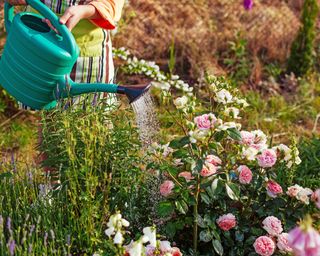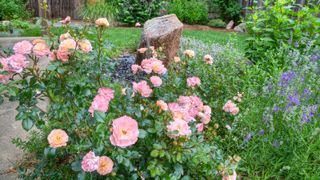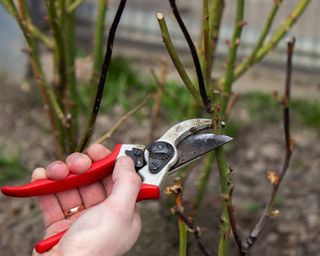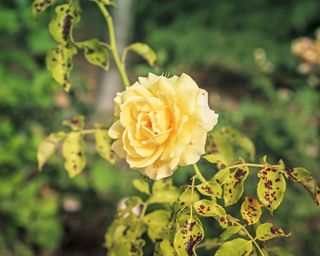Roses are beloved for their unparalleled beauty and fragrance. However, these shrubs can suffer from a number of problems that can affect their health and appearance. It takes a dedicated gardener to cultivate a rose garden full of perfect specimens, but learning how to save a rose can be incredibly rewarding.
Depending on where you live, roses may be more susceptible to certain pests and diseases. Cultural conditions such as watering regimens, pruning methods, and rose cutting errors are also potential problems that can cause shrubs to decline in health.
The first step to recovering a struggling rose is to identify the underlying problem. Regularly inspect your plant for signs of stress, pests, and environmental factors. Early detection and intervention are key to maintaining healthy roses.
By addressing these common problems, with a little patience and regular care, you will be able to save your roses and enjoy their beautiful blooms once again.
1. Review your watering habits
Watering your roses is an important part of caring for them. If done incorrectly, your plants will soon have health problems.
Insufficient watering is a common cause of plant deterioration, resulting in wilting and stunted leaves. Leaf margins often turn yellow, and the area becomes crusty and dry. Flowers will also be affected, wilting and dying prematurely.
However, when plants are not growing well, gardeners can overcompensate by overwatering. Overwatered plants will have yellow veins or yellow leaves. They may also develop root rot.
Roses need water on average every other day in the summer. Water deeply to encourage deep root growth and avoid overhead watering to prevent fungal diseases. Use a targeted drip system to direct moisture to the roots.
Instead of watering on a schedule, regularly check the moisture in the top 2 inches of soil. Push your finger down to your knuckle – if the soil is dry, it’s time to water.
Maintaining consistent soil moisture is also important, especially during dry periods. Mulching your roses can help retain moisture and keep the roots cool.

(Image source: Shutterstock)
2. Check the light level
When roses are struggling, sometimes the simplest explanation is that they are not getting enough sunlight. Roses grow best in full sun, and planting them in shade will result in weak, stunted growth and fewer flowers.
Check the location of your rose plant and make sure it gets at least six hours of direct sunlight each day.
If your rose is in a shady spot, consider transplanting it to a sunnier location. The best time to do this is in early spring, before the plant sends out new growth. However, if the shrub cannot wait, you can move it in the summer, away from hot, dry weather.
3. Improve soil health
Healthy soil is essential to reviving a struggling rose. Roses will grow in a wide variety of soils, but they prefer well-drained sandy loam that is rich in organic matter.
When they are in clay or heavy soil, excess water may not be able to percolate away, leading to root rot.
You can improve the soil around existing plants by mixing in compost or well-rotted manure. This will improve the soil structure and fertility.
Also, check the pH of your soil – roses ideally need a pH of 6-6.5 to grow healthily. If the soil is too acidic or too alkaline, it can lead to poor plant health and stunted growth. Acidic soils can be improved with lime; alkaline soils can be improved with sulfur.

(Image source: Alamy)
4. Add fertilizer
Roses need plenty of fuel to grow leaves and stems – but they also need beautiful flowers. When a plant doesn’t get the nutrients it needs, it will develop symptoms like yellowing leaves, failing buds and stunted growth.
Rose plants that are not well cared for are at higher risk of pests and diseases than plants that are well nourished.
If you haven’t fertilized your roses recently, you can encourage new growth by fertilizing them. Use a balanced fertilizer formulated for roses to provide the right nutrients. Follow the manufacturer’s instructions for rate and timing of fertilization.
Fertilize in early spring and continue to fertilize every 4-6 weeks through late summer. Avoid fertilizing in the fall as this can promote new growth that is susceptible to winter damage.
However, do not over-fertilize your roses. Over-fertilizing can cause root burn, dark patches on the leaves, and excessive leaf growth with few flower buds.
5. Prune damaged areas
Roses do need pruning. Not only do we prune to remove dead wood and shape the plant, but more importantly they need to be pruned at the right points on the stem to encourage flowering.
Cut back one-third of the growth in late winter, cutting the canes just above a growth node. Tilt the cut so water and dew run off the wound and don’t pool in it.
Tree dieback is the result of poor pruning practices, where the cut is not made at the growing point. This unsightly condition causes brown and black dead stems to protrude from the tree.
If your rose is doing poorly in the summer, try removing any dead, damaged or diseased branches. This will reduce congestion and allow the plant to focus on new growth. Also, remove any rose buds growing below the graft line, which will take energy from the plant and limit the potential for new growth.
Use sharp, sterilized pruning shears to make clean cuts. Remove any debris that falls around the base of the plant as it may harbor pests.

(Image source: Getty Images)
6. Pest control
Inspect your rose plants closely for signs of pests and disease – some are more visible than others, but all are stressful for the plant. Check the leaves for pests and damage, including the undersides, and look for flower buds that are not opening.
Common pests and diseases of roses include aphids, Japanese beetle, leaf cutter bee, ratio, weevilAnd arrange
Insecticide soap, Neem OilLadybugs, hand picking, and systemic insecticides are all ways to combat insect pests. Use insecticides only as a last resort.
However, the best protection against pests is a healthy plant. Good care and keeping your plants healthy means they can withstand a small infestation of snacking insects.
In the long term, attract beneficial insects, such as ladybugs, to help control pests. Plant a variety of native plants to support wildlife and promote biodiversity.
7. Treatment
Black spot, powdery mildew, rust, canker, and many other fungal diseases are all common rose problems that can affect the health of the plant. Check the leaves for signs of infection.
Foliar diseases such as black spot will not kill the plant, but they can reduce its vitality because leaf drop prevents photosynthesis. Cankers can allow more disease to enter the plant’s vascular system or even constrict the stem, preventing the movement of water and nutrients.
There are many fungicides available for use on a variety of diseases, including natural remedies for black spot. Prune plants to allow good air circulation and keep them from being too close together. Make sure the soil is well drained. Avoid overhead watering and splashing muddy water on the leaves and stems.
Disinfect pruning shears between cuts and remove any debris underneath the plant that may contain fungal spores.
In the future, consider choosing varieties that are resistant to diseases common in your area.
Viral diseases can also wreak havoc on plants. Watch out for rose mosaic and rosette disease. Rose mosaic causes yellow streaks, rings, or patterns on leaves in the spring. Rosette disease causes unusual growths called witches’ brooms.
There is no treatment for rose mosaic disease and the plant must be destroyed. Rose mosaic disease is caused by a small insect, the eriophyid mite. Unfortunately, there is also no treatment for this disease and the plant must be destroyed.

(Image source: Getty Images)
8. Chemical damage treatment
Applying herbicides when it is windy is a bad idea. The wind will carry the spray wherever it wants, not necessarily where you want it. This is called drift and is a common occurrence when applying herbicides.
Glyphosate and other chemicals can cause serious damage to plants if they get on the leaves. In roses, the leaves become stunted, deformed, and curled up. They become discolored, mottled, and the edges become dry and brittle. Overall, the plant is stunted and no new growth occurs as the plant tries valiantly to save itself from the poison.
If only a few branches are affected, prune them and care for the rest of the tree to recover. If the entire tree is sprayed, there may be nothing you can do to save it.
